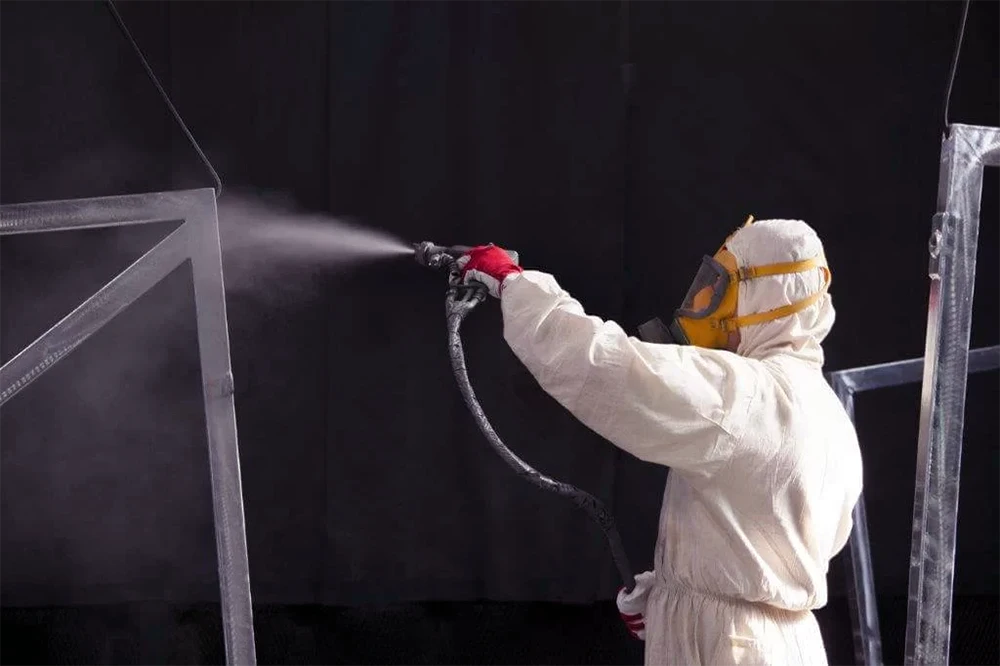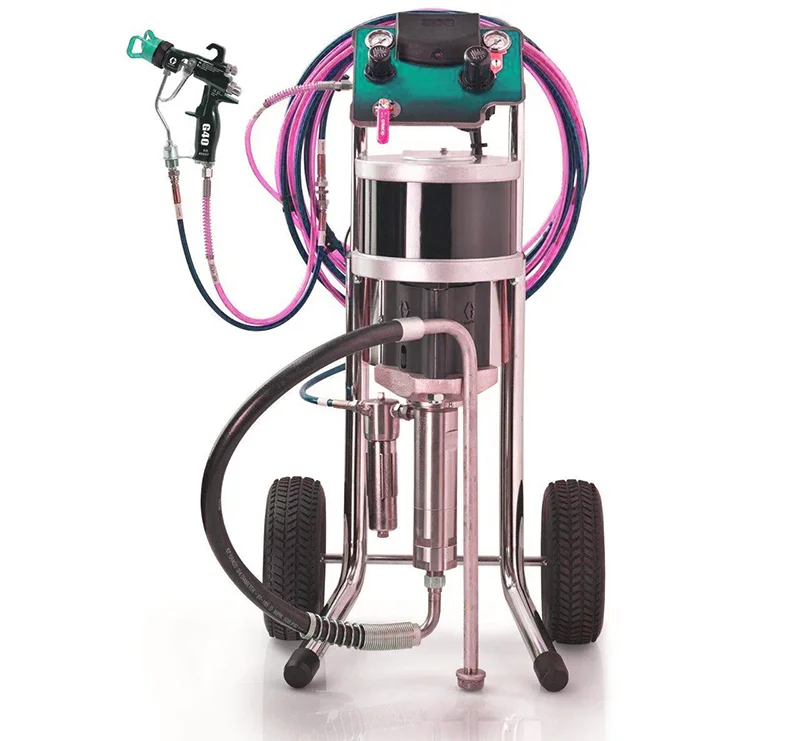Article Chapters
Achieving a perfect coating not only requires the right paint or coating material, but also depends on the quality and suitability of the spray equipment. Choosing the right paint spray equipment is crucial to getting the best paint results. From choosing the right spray system to knowing how to maintain and troubleshoot it, this guide covers everything you need to know about your paint spray equipment.
How to Choose Suitable Coatings Spray Equipment?
Choosing the right paint spraying equipment is like choosing the perfect brush for your masterpiece, it can make all the difference in results. Finding the perfect match for your paint spray system or equipment requires considering several factors to ensure optimal performance and efficiency. Factors to consider include project size, coating type (water-based, solvent-based, high solids, powder coating), application requirements, substrate material, object shape, coating surface quality, transfer efficiency, portability, ease of use, safety safety and environmental considerations, budget, long-term value and selected coating technology. Each factor plays a vital role in choosing the most suitable equipment. Let’s take a deeper look at these factors and provide specific guidance on choosing the right paint spray equipment and systems for your needs.

Factors to consider when choosing paint spray equipment:
- Project Size and Scope: Just like a superhero needs the right tools for the job, the spray equipment you choose should also match the size of your project. Determine the size of your project to select the appropriate equipment size and capacity. Larger projects may require an airless sprayer or an air-assisted airless sprayer, which can handle thicker materials and cover large surfaces quickly, resulting in significant time and labor savings. And handheld or HVLP (High Volume Low Pressure) sprayers are great for delicate, small-scale jobs. Click to learn more about spray system equipment types.
- Type of paint: Consider the viscosity and requirements of the paint you will be using and choose a sprayer that can handle its viscosity. For example, water-based coatings can be operated with lower pressure sprayers without affecting surface quality, making them ideal for use with HVLP sprayers. Solvent-based and thicker coatings require higher pressure spray systems, such as airless sprayers, that can handle higher viscosities without clogging.
- Application Needs:Consider the surface you want to paint and the accuracy required. For intricate patterns and high-quality finishes, consider using a sprayer with adjustable settings to control the spray pattern and flow rate. Airless sprayers, on the other hand, are better suited for large, flat surfaces. Different sprayers are suitable for different surfaces and application methods.
- Substrate material and shape:The material and shape of the object being coated will affect the choice of sprayer. Special surfaces may require specialized equipment for best results.
For example: For irregularly shaped objects choose a sprayer with a flexible hose and extension to reach tricky areas without compromising the quality of the application. And when dealing with delicate materials, choose a low-pressure sprayer to avoid damage. - Coating surface quality:Consider the finish required and the level of detail required. Some sprayers offer greater control over spray pattern and droplet size. When it comes to automotive or furniture finishes, a smooth, blemish-free surface is critical, and a fine finish sprayer or HVLP system provides the control needed to achieve a high-quality finish.
- Transfer Efficiency: Choose a sprayer with high transfer efficiency to minimize overspray and waste. Ensures more of the coating adheres to the surface, which is especially important for projects where material costs are a concern.
- Portability and Ease of Use:Just as a superhero needs to be agile, your spray equipment should be easy to maneuver and operate. Consider the sprayer’s weight, portability, and ease of cleaning. For jobs that require movement over a large area or multiple locations, consider lightweight, portable spray equipment with easy-to-setup features. And, choose a sprayer with intuitive controls and a simple cleaning process to save time and unnecessary hassle. Look for features like adjustable pressure settings and ergonomic design for added comfort and control.
- Safety and Environmental Precautions:Safety should always be your top priority. Look for sprayers with safety features, such as trigger locks and pressure relief valves, to prevent overspray and dangerous conditions. Also ensure that the spray system can handle non-toxic and environmentally friendly coatings. Consider the environmental impact of your choices – choosing low overspray and low VOC (volatile organic compounds) options can help minimize your carbon footprint.
- Budget and long-term value:Balance initial costs with operating and maintenance expenses. The initial cost may be significant, but more expensive sprayers may offer better long-term reliability and lower operating costs due to greater efficiency and fewer repairs. Look for warranties and customer reviews to ensure you’re getting a reliable product.
- Selected coating technology: Match your sprayer technology to the type of coating you plan to use. Different coating technologies may require specific spray equipment. Consider equipment compatibility with the chosen coating technology. For example: Advanced technologies such as electrostatic sprayers are applied to conductive materials to enhance adhesion and reduce waste.
Specific Guidelines for Selecting Paint Spray Equipment and Systems
- For small to medium-sized projects using water-based coatings, consider an HVLP sprayer for its precision and control.
- For larger projects using Oil-based coatings, an airless sprayer may be more suitable because of its efficiency and coverage.
- For industrial spraying projects using powder coatings, choose an electrostatic spraying system to achieve reliable and high-quality spraying.
- When working on delicate surfaces like furniture or upholstery, choose a sprayer with adjustable pressure settings and a fine spray pattern.
- For projects that require portability, choose a sprayer that is lightweight and easy to operate.
- Make sure the equipment you choose meets safety standards and environmental regulations in your area.
Choosing the right paint spray equipment is all about finding the perfect balance between functionality, efficiency and ease of use. In addition to ensuring that the equipment meets the specific needs of your project, it also needs to be compatible with the coating technology you plan to use. By carefully considering these factors and following the specific guidance provided, you can select the appropriate paint spray equipment and systems. Helps you achieve a perfect finish like a real painting superhero. So, be prepared, choose wisely, and make your coating shine! After you have a clear selection goal, you can use the intelligent filtering function of coatingsdirectory.com to select reliable spray equipment manufacturer procurement to help optimize your work efficiency.
How to Clean and Maintain your Painting System?
Keeping your paint sprayer in top-notch condition is crucial for ensuring its longevity and efficiency. Regular maintenance not only keeps the equipment running smoothly but also prevents frustrating clogs and uneven paint application. Here’s a comprehensive guide on how to clean and maintain your painting system, peppered with professional insights and engaging tips to make your maintenance routine less of a chore and more of a rewarding practice.
Step-by-Step Guide to Cleaning Your Paint Sprayer:
- Safety First
Before you begin, ensure the power is off and your workspace is well-ventilated. Wear gloves and safety goggles to protect yourself from harsh cleaning chemicals and paint residues. - Flush the System
Start by flushing out the remaining paint. If you’ve used water-based paint, run warm soapy water through the system. Read detailed cleaning & thinning instructions for water-based paints. For oil-based paints, use mineral spirits. Attach the suction tube to a waste pail and the return tube to a cleaning solution, and allow the machine to pump the cleaner through until it runs clear. - Disassemble the Sprayer
Carefully disassemble the spray gun and hose. Remove the filter, nozzle, and any other components that come into contact with paint. This will allow you to clean each part more thoroughly. - Clean the Components
Use a soft brush and a suitable cleaning solution to scrub each part. Pay special attention to the nozzle and the filter, as these can become clogged with paint residues, affecting the spray quality and efficiency. - Rinse and Dry
After cleaning, rinse all parts with clean water (or more mineral spirits for oil-based paints) to remove any remaining cleaner or paint. Allow all components to air dry completely before reassembling the sprayer. - Lubricate the Moving Parts
Apply lubricant to any moving parts to ensure smooth operation and protect against rust and wear. This step is crucial for extending the life of your equipment. - Reassemble and Store
Once everything is dry and lubricated, reassemble your paint sprayer according to the manufacturer’s instructions. Store it in a clean, dry place to avoid dust and dirt buildup.

Please note that some accessories or parts of the spray painting equipment are consumables. Therefore, please check the corresponding accessories during daily cleaning and replace them regularly. For specific information on which accessories are prone to wear and tear, you can read the spray equipment manual or contact the equipment manufacturer’s customer service for technical support.
Why Regular Maintenance is Critical?
- Efficiency and Performance:Regular cleaning ensures that your spray paint machine operates at peak efficiency. A clean sprayer delivers even coatings and accurate spray patterns, reducing the need for touch-ups and additional coats.
- Cost Savings:Maintaining your spray equipment can prevent costly repairs or replacements down the line. By investing time in routine maintenance, you save money by extending the life of your sprayer.
- Quality Results:A well-maintained sprayer is more likely to produce high-quality finishes. This is crucial for professional painters who rely on their reputation for meticulous work.
- Prevents Downtime:Routine maintenance reduces the likelihood of sudden malfunctions or clogs, which can cause delays in your painting projects. Keeping your equipment in good working order ensures that it’s ready to go when you are.
Cleaning and maintaining your paint sprayer might seem like a tedious task, but it’s a fundamental part of owning spray equipment. By following these steps, you not only ensure that your sprayer runs efficiently but also contribute to its longevity and reliability. Consider this routine maintenance as part of your craft, a way to ensure that every paint job reflects your commitment to quality and efficiency. Happy spraying!
What Are Common Issues with Coating Spray Equipment?
When it comes to coating spray equipment, even the mightiest heroes can encounter a few bumps in the road. From clogs to leaks, these common issues can turn your painting project into a real-life drama. But fear not, for every problem has a solution, and we’re here to guide you through the most common challenges faced with coating spray equipment. Let’s dive into the world of troubleshooting and make your next project a smooth-sailing adventure!
- Clogged Nozzles
Picture this: you’re in the middle of a painting project and suddenly, your airbrush starts sputtering like a tired superhero without even spraying paint. This is usually caused by paint or debris clogging the nozzle or nozzle. Have no fear, brave painter! Simply clean the nozzle with an appropriate solvent or cleaning solution and your sprayer will be back working in no time. Of course, regular cleaning is also important! - The spray shape is uneven
If your sprayer leaves patchy marks, it may be due to an uneven spray pattern. This can happen when the paint has the wrong viscosity, the nozzle is worn or damaged, or the air pressure is set incorrectly. Make sure the paint is diluted correctly, check the nozzle for damage and replace if necessary. Adjust air pressure for a smooth, even spray pattern. - Leaking
Just like superheroes need tight-fitting costumes, your spray painting equipment needs to be airtight to work properly. A leaking spray gun can turn your painting project into a mess. Leaks can occur due to worn or damaged seals at connections or on the gun itself, loose fittings, or improper assembly. Check the gun for any obvious damage and tighten any loose fittings. If the problem persists, replace the seal or consult the manufacturer for further assistance. - Over-spraying
Overspray can result in wasted paint and an uneven surface. This can be caused by using the wrong nozzle size, wrong air pressure, or poor technique. To minimize overspray, choose the correct nozzle for your paint viscosity and adjust the air pressure for a finer spray. Of course, the painter’s correct spraying technique is also key to success. - Poor atomization
Poor atomization results in a rough, textured surface. This can be caused by using the wrong type of paint or diluting the paint too much. Make sure you are using the correct type of paint for your sprayer and follow the manufacturer’s dilution recommendations.
While these common issues with coating spray equipment may seem daunting, with the right knowledge and techniques, you can overcome them like a true painting superhero. By understanding these challenges and taking proactive steps to address them, you’ll be well-equipped to tackle any painting project with confidence and precision. Remember, the key to successful painting lies not only in the quality of your equipment but also in your skill and preparation!
Where Can I Find Reliable Spray System Equipment and Accessories?
Looking for reliable spray system equipment and accessories is like embarking on a quest for the perfect painting tools—there are many paths to explore! Whether you’re a seasoned pro or a DIY enthusiast, finding the right equipment can make all the difference in achieving a flawless finish. Here’s a guide to help you navigate the maze of options and find the spray system of your dreams.
- Local Hardware Stores
These are the bread and butter of equipment hunting. Local hardware stores often carry a variety of spray system equipment and accessories, from spray guns to hoses and nozzles. The advantage of shopping here is the convenience and the ability to see and touch the products before buying. - Specialty Paint Stores
For those looking for more specialized equipment or high-quality brands, specialty paint stores are the place to go. They often carry a wider range of products tailored specifically for painting professionals and enthusiasts. Plus, the staff are usually knowledgeable and can offer expert advice. - Online Retailers
The internet is a treasure trove of spray system equipment and accessories. Online retailers like Amazon, eBay, and specialized paint equipment websites offer a vast selection of products at competitive prices. Be sure to read reviews and check the return policy before making a purchase. - Manufacturer Websites
If you’re looking for a specific brand or model, checking the manufacturer’s website is a good idea. Many manufacturers sell their products directly to consumers online, and you may find exclusive deals or discounts by purchasing directly from them. - Secondhand Stores and Online Marketplaces
For those on a budget or looking for a deal, secondhand stores and online marketplaces like Craigslist, Facebook Marketplace, or local buy/sell/trade groups can be a goldmine. Just be sure to inspect the equipment thoroughly before purchasing. - Coatings Directory
For a more streamlined and efficient search, consider using the Coatings Directory platform. With its intelligent filtering functionality, you can easily find the spray system equipment and accessories you need. Simply input your requirements, and let the platform do the work for you, connecting you with reliable suppliers in no time.
With so many options available, finding reliable spray system equipment and accessories is easier than ever. Whether you prefer the convenience of local stores, the wide selection of online retailers, or the expertise of specialty paint stores, there’s a perfect spray system out there waiting for you. And remember, for a hassle-free search, don’t forget to utilize the smart filtering feature on Coatings Directory to find exactly what you need. Happy spraying!
All in all, proper selection, maintenance, and troubleshooting of spray equipment are critical to achieving high-quality spray results. By choosing the right equipment, maintaining it properly, and resolving any issues that arise, you can ensure that your project is a success and that your coatings are applied with precision and care. CoatingsDirectory wishes you every success with your painting project!
How to thin paint for sprayer?
To thin sprayer paint, be sure to follow the manufacturer’s instructions for the specific paint and sprayer you are using. Typically, you will need to add the appropriate thinner to achieve the desired consistency. Water-based paints typically use water, while oil-based paints use turpentine, white spirit or paint thinners. The key is to slowly add thinner while stirring constantly until the paint reaches a thickness suitable for spraying. It’s a good idea to test diluted paint on a small surface before spraying to make sure it flows smoothly and evenly.
How to clean and maintain your paint sprayer?
Cleaning and maintaining your paint sprayer is essential to keeping it in good working order. After each use, flush the sprayer with an appropriate cleaning solution to remove any remaining paint. Periodically disassemble the sprayer and clean each part thoroughly to prevent clogging and ensure proper operation. Check the sprayer regularly for any damage or wear and replace parts as necessary. Proper storage in a clean, dry area is also important to prevent damage and maintain performance.

